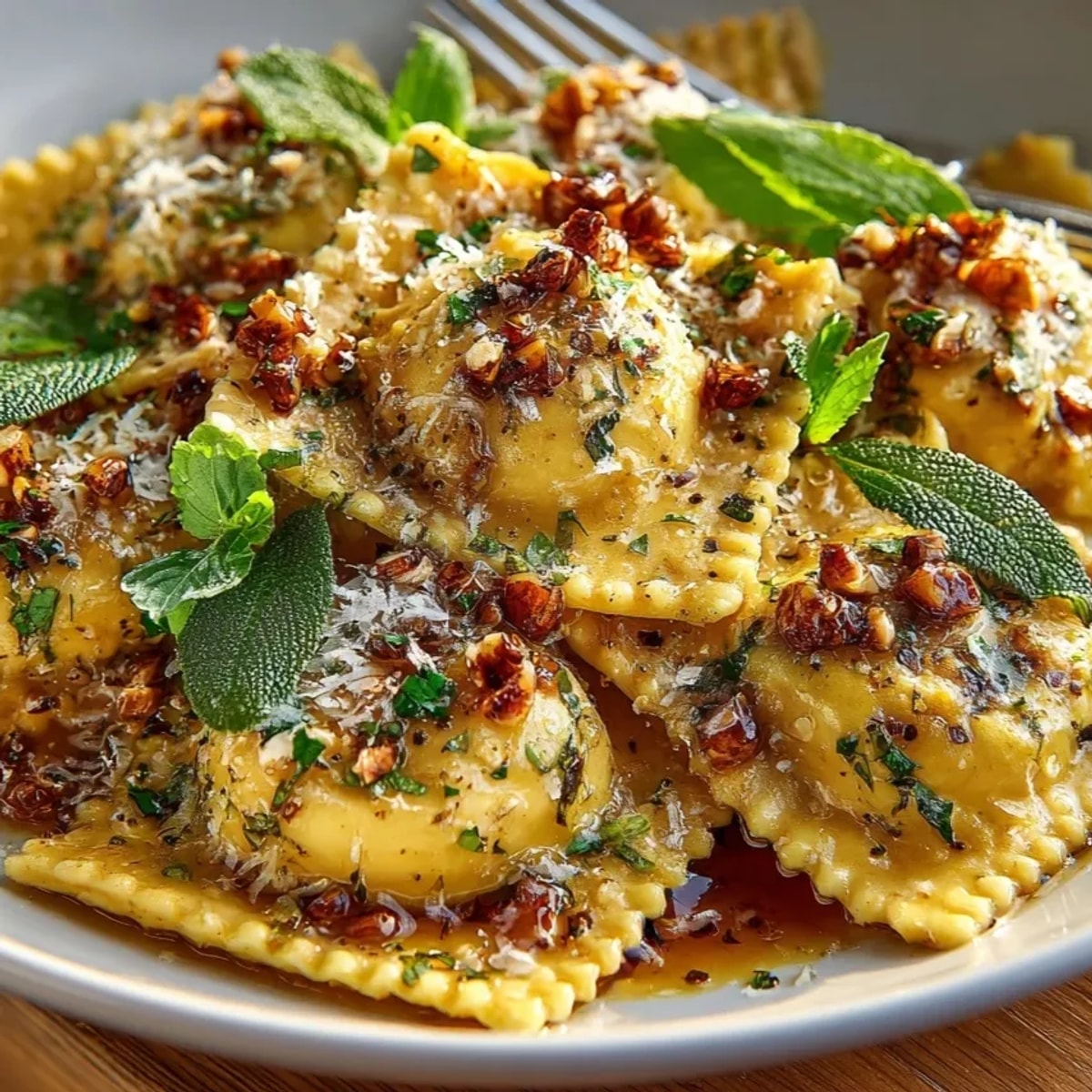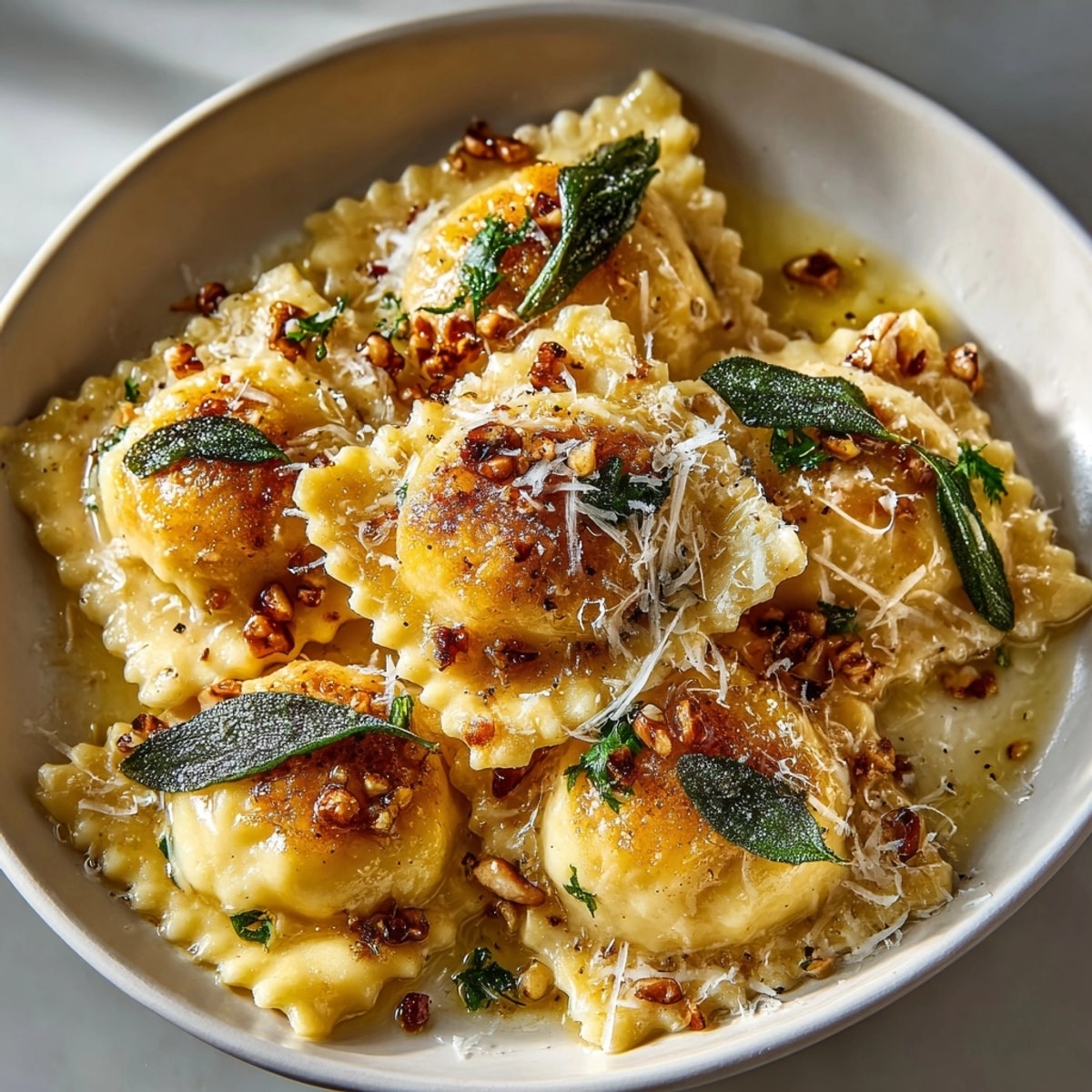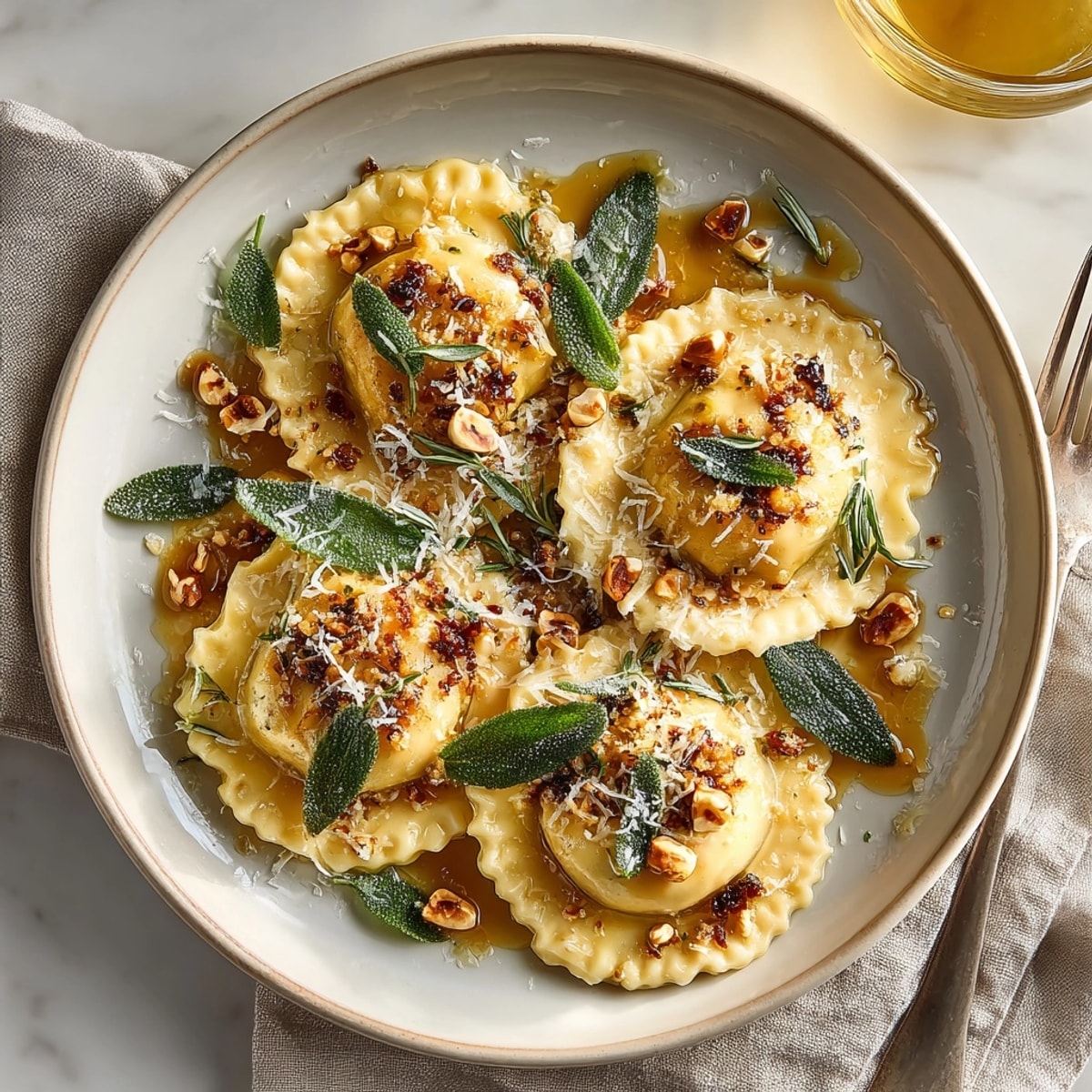 Save
Save This homemade acorn squash ravioli transforms humble ingredients into an elegant dish that tastes like it came from a fine Italian restaurant. The sweet roasted squash filling paired with nutty brown butter creates a harmony of flavors that makes this dish truly special, while the fresh sage adds an aromatic finishing touch that elevates the entire experience.
I first made this ravioli for a holiday dinner with my in-laws, and it's become our tradition for celebrating milestones. The process of making pasta from scratch has become almost meditative for me, and the looks of delight when people take their first bite makes every minute of preparation worthwhile.
Ingredients
- All purpose flour: creates the perfect elasticity in homemade pasta. Look for unbleached varieties for best flavor.
- Large eggs: bind the pasta dough and provide richness. Farm fresh eggs with vibrant orange yolks add beautiful color.
- Acorn squash: offers natural sweetness and velvety texture. Choose one that feels heavy for its size with firm, unblemished skin.
- Ricotta cheese: adds creaminess to the filling. Select whole milk ricotta for the richest flavor.
- Parmesan cheese: brings umami depth. Always buy a block and grate it yourself for superior taste.
- Nutmeg: enhances the squash's natural sweetness. Freshly grated makes a noticeable difference.
- Unsalted butter: forms the base of your sauce. European style with higher butterfat creates a richer brown butter.
- Hazelnuts: provide wonderful texture contrast and nutty flavor. Look for blanched ones to save peeling time.
- Fresh sage leaves: become crispy and aromatic in the brown butter. Choose leaves that are vibrant green without any wilting.
- Lemon zest: brightens the entire dish. Organic lemons work best as you're using the outer peel.
Instructions
- Roast the Squash:
- Preheat your oven to 400°F and slice your acorn squash in half from stem to tip. Scoop out all the seeds and stringy bits using a spoon. Brush the cut surfaces generously with olive oil and place them cut side down on a baking sheet. Roast for 30 to 35 minutes until the flesh yields easily when pierced with a fork. The caramelization that happens during roasting develops deep flavor compounds that make your filling exceptional.
- Prepare the Filling:
- Once your squash has cooled enough to handle, scoop the soft flesh away from the skin and into a medium bowl. Mash it thoroughly with a fork until smooth. Add the ricotta, grated Parmesan, nutmeg, salt, and pepper. Stir until everything is fully incorporated. Taste and adjust seasonings if needed. The filling should be flavorful enough to shine through the pasta.
- Make the Pasta Dough:
- Create a mound of flour on a clean work surface and form a well in the center large enough to hold your eggs. Crack the eggs into this well along with salt and olive oil. Using a fork, beat the eggs while gradually incorporating flour from the inner walls of your well. Once the mixture becomes too thick for a fork, use your hands to bring everything together. Knead the dough for a full 10 minutes until it becomes smooth and elastic. This develops the gluten structure that gives your pasta the perfect texture.
- Rest the Dough:
- Wrap your kneaded dough tightly in plastic wrap and let it rest at room temperature for 30 minutes. This relaxes the gluten and makes the dough easier to roll out. Never skip this resting phase as it dramatically improves your final pasta texture.
- Roll the Pasta:
- Divide your rested dough in half to make it more manageable. On a lightly floured surface, roll one portion at a time into a very thin sheet. You should be able to see the shadow of your hand through it. If using a pasta machine, gradually work through the settings until you reach the second to last thickness setting. Keep unused dough covered to prevent drying out.
- Form the Ravioli:
- Place teaspoons of filling along one pasta sheet, leaving about 1½ inches between each mound. Lightly brush the exposed pasta around each filling mound with water to create a seal. Carefully place your second sheet on top, pressing around each mound of filling to seal while pushing out any air bubbles. Air pockets can cause ravioli to burst during cooking.
- Cut and Seal:
- Use a knife, pastry wheel, or ravioli cutter to cut your pasta into individual ravioli. Press the edges firmly to ensure they're well sealed. Transfer completed ravioli to a floured baking sheet, making sure they don't touch each other.
- Cook the Ravioli:
- Bring a large pot of generously salted water to a boil. The water should taste like the sea. Gently add your ravioli in batches to avoid overcrowding, which can cause them to stick together. They'll cook quickly, just 2 to 3 minutes, and will float to the surface when done. Remove with a slotted spoon rather than draining to avoid breaking them.
- Make Brown Butter Sauce:
- While the pasta water comes to a boil, melt butter in a wide skillet over medium heat. Add the chopped hazelnuts and sage leaves. Watch carefully as the butter begins to foam and the milk solids turn golden brown. You'll notice a nutty aroma developing. This happens quickly, so have everything else ready before starting this step.
- Finish and Serve:
- Transfer cooked ravioli directly to warmed plates. Spoon the hazelnut brown butter sauce evenly over each serving, making sure to include sage leaves and nuts. Finish with freshly shaved Parmesan and extra hazelnuts if desired. Serve immediately while the pasta is tender and the sauce is warm.
 Save
Save Acorn squash holds a special place in my heart because it was the first winter squash I ever grew in my own garden. I remember harvesting that first squash on a crisp October morning, its skin still glistening with dew. The sweet, nutty flavor of homegrown acorn squash is unmatched by anything you'll find in stores, but even store bought varieties create a ravioli filling that's absolutely divine.
Storage and Make-Ahead Tips
Uncooked ravioli can be frozen for up to 3 months. Arrange them in a single layer on a baking sheet until completely frozen, then transfer to an airtight container with parchment paper between layers. Cook directly from frozen, adding 1 to 2 minutes to the cooking time.
The filling can be made up to 2 days in advance and stored in an airtight container in the refrigerator. This actually allows the flavors to meld and develop, resulting in a more flavorful ravioli.
Leftover cooked ravioli will keep in the refrigerator for up to 2 days. Reheat gently in simmering water for about 1 minute or in a covered skillet with a splash of water over low heat.
Ingredient Substitutions
Butternut squash works beautifully in place of acorn squash, offering a similar sweetness with an even creamier texture. Just adjust roasting time as needed until fork tender.
No hazelnuts? Walnuts or pine nuts make excellent substitutions in the brown butter sauce, each bringing their own unique flavor profile to the dish.
For a dairy free version, use olive oil in place of butter for the sauce and substitute the cheese filling with a mixture of pureed white beans, roasted garlic, and nutritional yeast.
Gluten free all purpose flour blends designed for pasta making can replace traditional flour, though you may need to adjust the liquid slightly to achieve the proper dough consistency.
Serving Suggestions
This ravioli pairs beautifully with a simple arugula salad dressed with lemon vinaigrette. The peppery greens and bright acidity cut through the richness of the brown butter.
For wine pairing, choose a medium bodied white with good acidity like Pinot Grigio, Vermentino, or an unoaked Chardonnay. The crisp notes complement the nutty richness of the dish.
Consider serving smaller portions as a stunning first course for a dinner party, followed by a simple roasted chicken or fish main course.
Seasonal Adaptations
Spring Version
Replace acorn squash with fresh peas and mint
Lighten the sauce with lemon juice and less butter
Garnish with pea shoots and edible flowers
Summer Variation
Substitute roasted sweet corn and basil for the squash filling
Use brown butter with toasted pine nuts instead of hazelnuts
Finish with cherry tomatoes and basil oil
Winter Holiday Special
Add a touch of maple syrup to the squash filling
Include crushed amaretti cookies in the filling for sweetness
Garnish with fried sage leaves and pomegranate seeds
 Save
Save Enjoy this comforting and elegant dish that's perfect for both everyday meals and special occasions. The homemade pasta and flavorful filling are sure to impress.
Recipe Questions
- → What can I substitute for acorn squash?
Butternut squash is an excellent alternative, offering a similar sweet, smooth flavor and texture.
- → How do I prevent ravioli from bursting while cooking?
Seal the edges well and avoid overfilling. Boil gently in batches to keep ravioli intact.
- → Can I make the pasta dough ahead of time?
Yes. Prepare and refrigerate the dough up to 24 hours in advance. Allow it to come to room temperature before rolling.
- → What wine pairs well with this dish?
A crisp white wine such as Pinot Grigio or Sauvignon Blanc complements the buttery, nutty notes.
- → Are there nut-free alternatives for the sauce?
For a nut-free version, simply omit hazelnuts and enhance flavor with extra sage and a touch of lemon zest.